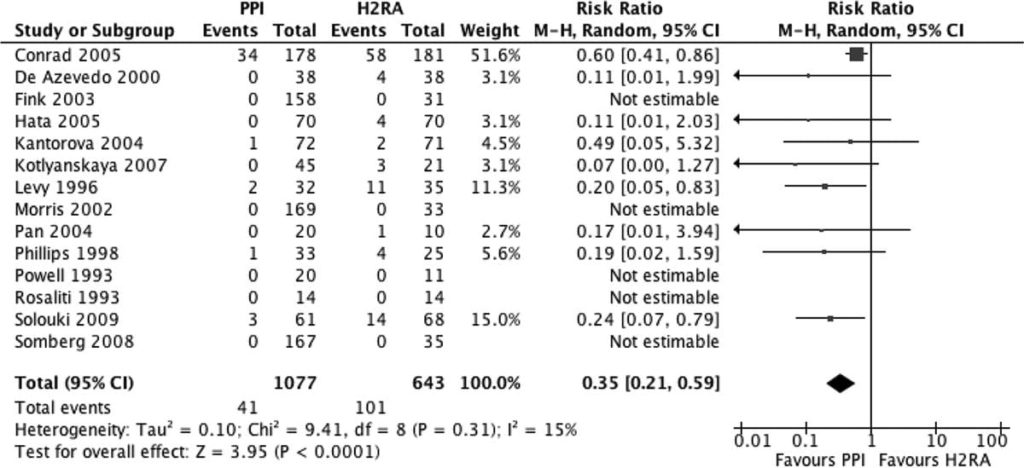CICM SAQ 2015.1 Q8
Question
A systematic review of the literature was undertaken comparing proton pump inhibitors with H2- receptor blockers for the prevention of gastro-intestinal bleeding in ICU patients.
The following figure was included:
- a) Name the type of graph illustrated in the above figure. (10% marks)
- b) What does it show? (25% marks)
- c) What are the benefits of this type of analysis? (25% marks)
- d) What are the disadvantages of this analysis? (40% marks)
Answer
Answer and interpretation
a) Name the type of graph illustrated in the above figure. (10% marks)
- Forest plot
b) What does it show? (25% marks)
- Combining the trials together, PPI use results in an odds ratio of 0.35 or reduction in the risk of bleeding compared to H2RA. Alternatively, PPI use results in 65% reduction (1- 0.35) in bleeding.
c) What are the benefits of this type of analysis? (25% marks)
- Combines small studies with limited power, increasing the number and thus the ability to pick up a positive effect. Small studies with low power (due to small effect, small numbers) run the risk of a Type II error.
d) What are the disadvantages of this analysis? (40% marks)
- Individual studies might have different patient populations (with different risk of bleeding) or different definitions of outcome.
- Individual studies might have been conducted with different degrees of rigour (blinding, etc.)
- There is publication bias to positive studies so that negative studies are not reported.
- Need full disclosure how the studies were selected, their scientific grading, subgroup analyses and assessment of heterogeneity.
- Pass rate: 83%
- Highest mark: 8.0
Additional comments:
- Candidates who scored well showed an in-depth understanding of the applied physiology and consequences of the various therapeutic options. Candidates who scored poorly omitted key points.

Examination Library
CICM
Chris is an Intensivist and ECMO specialist at The Alfred ICU, where he is Deputy Director (Education). He is a Clinical Adjunct Associate Professor at Monash University, the Lead for the Clinician Educator Incubator programme, and a CICM First Part Examiner.
He is an internationally recognised Clinician Educator with a passion for helping clinicians learn and for improving the clinical performance of individuals and collectives. He was one of the founders of the FOAM movement (Free Open-Access Medical education) has been recognised for his contributions to education with awards from ANZICS, ANZAHPE, and ACEM.
His one great achievement is being the father of three amazing children.
On Bluesky, he is @precordialthump.bsky.social and on the site that Elon has screwed up, he is @precordialthump.
| INTENSIVE | RAGE | Resuscitology | SMACC

